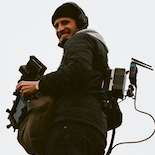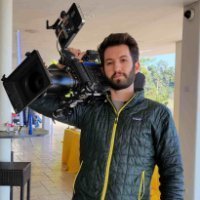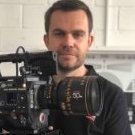-
Posts
899 -
Joined
-
Last visited
About Brian Rose
- Birthday 05/04/1984
Profile Information
-
Occupation
Student
-
Location
Kansas City area
-
Specialties
All things cinema and cinematography, as well as American history, running and restoring 50s milkshake machines
Contact Methods
-
Website URL
http://
Recent Profile Visitors
-

Murder on the Orient Express in 70mm
Brian Rose replied to Tyler Purcell's topic in In Production / Behind the Scenes
I hope you make it happen! I'm in post production on my new documentary, which I shot entirely on S16mm BW. I kept to a very strict shooting ratio, right around 5:1 which is very tight for a doc, but I did not feel confined at all, because I did a ton of leg work on pre-pro, including storyboarding and having shot lists, so when it came to production, in a lot of cases I only needed one or two takes of a lot of scenes, which enabled me more freedom on the complex shots. I love doing animation, and would love to shoot something on 35mm still so I could have a negative format akin to VistaVision. -

Murder on the Orient Express in 70mm
Brian Rose replied to Tyler Purcell's topic in In Production / Behind the Scenes
I would echo this sentiment. I once had the privilege of seeing Lawrence of Arabia in two formats - a 70mm print from the first restoration, and a 4K DCP from the most recent. What I found was that BOTH formats had their strengths. I found the 70mm print to be a bit more lush in terms of color, and richer in contrast, but the 4K won out in terms of detail and grain, because one was sourced from the negative, while the print represented a couple generations of loss. Ultimately, the image quality of the original source medium is what matters, and that original clarity carries over in either medium. I've said it before, and I'll say it again: regardless of exhibition medium, be it film or digital, large format or DCP, if a studio really wants to go for maximum versatility and future resilience, they'd do well to consider shooting 65mm, at least, for their bigger budgeted films where the additional cost of stock and processing is a relatively small percentage of the whole budget. I mean, if a film is already $150,000,000, what is another 500K or 1 mil more for 65? -
Hello all! I'm in post on a documentary I've been working on for quite some time. It's a feature, shot entirely on S16mm black and white (Orwo 400 ASA pushed 2 stops), and scanned in 4K to dpx files. I'm debating just how I want to grade this footage for the final edit. Now if it was HD or color footage, I'd go DaVinci all the way, but since I'm dealing with black and white film, which I've intentionally shot to be grainy and contrasty, does DaVinci really offer any advantages over Premiere? I come from a photographic background as well and really favor doing luma curves within the lumetri filter, and have been very satisfied with the results. But of course, if DaVinci offers some distinct advantages qualitatively over premiere, I want to take that into consideration. What say you all? Should I grade my BW in DaVinci, or am I good to stick with Premiere? Thanks! BR
-
Early this month I began shooting my new documentary. It's a feature being shot entirely on Super 16 BW, and Cinelab is doing the processing and the 4K scan. I've used Cinelab for more than ten years, and this is by far the biggest job they've done for me. I don't know where to start. The great rate they've given me. The great service. The kind accommodation to my requests. The fact they've never once erred in a processing job. They're simply terrific, and I'd use no other lab. For what it's worth, thanks Rob H and everyone at Cinelab. I know it's not much now, but if the film succeeds, it will be due in no small part to Cinelab's professionalism, and I will continue to sing praises! Brian Rose Cinelab customer since 2004
-
Hey all! I'm trying to pull off a particular lighting effect for my documentary. I want to highlight particular details on a photograph, and would love to do an effect akin to the old silent film iris in/out where in a spot of light on the document/photo contracts or expands. Is there an iris type attachment I can mount on the end of a snoot, to achieve this effect? Your help would be most appreciated! BR
-
I'm going to be shooting in Chicago this fall for a documentary, and I'm looking for shooters in the area who could assist me. I'm shooting Super 16, so having a film background is a plus, but not requisite. If you are interested, I'd love to hear from you! Brian Rose brrfilm@gmail.com
-
Don't let the naysayers get you down. But also, don't put all your eggs in one basket. Cannes is a great goal, and you should have high aspirations (because honestly, why bother making films if you don't dare to dream to make the best and shoot for the best?), but also have some fallbacks in mind. Because these days there are so many options and alternatives. If I have a regret, it's that I let myself get too bogged down in film festival politics, and when my feature didn't get screened I thought it was because it was a bad film, and I gave up on trying to put it out there. In hindsight I wish I had tried other routes, smaller festivals, direct distribution VOD, streaming, you name it. So reach for the stars, but be prepared for rejection and have other plans in place. Be prepared (and willing) to schlep it around to colleges or art house theaters yourself if need be. It may be hard to do, since you've invested so much of your time and money in a project, but try to think of it less like a work of art, and more like a product. You're proud of this product, and you think there are customers out there. So what if the "big box" retailers don't want your product? Those customers may still be there. Go find them! And good luck!
-

Buy film stock in bulk or piecemeal for shoot?
Brian Rose posted a topic in Film Stocks & Processing
Hey all, here's a question about dealing with film in large quantities. I'm going to start shooting a new project soon which because of the nature of the production, will shoot piecemeal, through the summer, fall and winter. I'm shooting BW 400 ASA orwo. My question is: should I buy all my stock at once and take advantage of the savings by buying in bulk, and then just keep what I don't use refrigerated until such time as I do need it? Is it better to ensure all the stock is from the same batch and vintage, for consistency's sake? Or is it wiser to buy stock only as it is needed to ensure it is as fresh as possible? Thanks! -

16mm 4K scan edit workflow for digital and film out 23.98 or 24p?
Brian Rose replied to Brian Rose's topic in Post Production
Thanks! I may give that Prores a try. I like to get DPX from the lab because it's nice to have the film is the "rawest, most uncompressed" state possible, and because the lab charges extra to do the conversion. But on your advice I may try converting the DPX to prores XQ. I'm shooting BW negative - Orwo 400 since I'll be shooting in some tough locations, with low lighting, plus some night shooting. Had a lot of great results pushing up to 2 stops with that stock. The story itself is an incredible one. It's the culmination of three years of research. It's about a student who, while on a class trip, vanished without a trace. No clues, no indication if even a crime took place. If I can pull it off, it will be like In Cold Blood...minus the solution. -
Hey all, I'm getting closer to beginning shooting and editing of my new documentary! I'm shooting Super 16 BW and am getting a 4K scan. I'm having a little trouble nailing down my workflow, having done some earlier tests with transcodes and relinking to DPX files, and the results were rather wonky, with cut points changing when I relink, etc, etc. I suspect I made a mistake with the frame rate, and wanted to pose this general question to you all about workflow. My goal is to have a 4K master, for theaters and for future resilience as UHD blu-ray and UHD streaming gains further traction. I'd also like, if I successfully raise the money, to produce at least one 35mm print from the 4K DI so I can have that option as well. My plan is to get 4K DPX files, and for editing cut using 4K prores proxy transcodes. What I'm uncertain about is, just what framerate do I edit with and transcode to, given the stated goals for distribution? Do I use 24p or 23.976? Your help and expertise will be deeply appreciated! BR
-
Would you know it, I've used Cinelab since I started shooting film, way back in 2004. His lab will be doing the processing and transfer!
-
I'm in prepro on a documentary that I've been researching and prepping for the last two years. I'm shooting on 16mm black and white, and when I started, I figured I would scan in 2k and go from there. But now, in 2016, I'm not so sure. Between 4K in the theaters, and emerging 4K in television and streaming online, does it make more sense to scan in 4K now, invest upfront so I've got that master already set? I've read different opinions on whether 16mm should be scanned in 4K. One camp says that 16mm really only has enough image information to warrant a 2K scan. Others say that a 4K captures more range and grain and resolves better when downsampled to HD. Or do I scan in 2K and upscale to 4K? What do you all think?
-
Steven, others might have more practical suggestions, but when I was going through school, and working on a budget, I would shortends (remember when you could get those?) and respool them onto 100ft daylight reels. And to do this I used a rewind table I set up in a photographic dark room. The only rub would be since you would be working with cores you'd need some kind of backplate to ensure it spools properly. But that's the best I can think of. So it sounds like 400 foot mags aren't an option for you? What do you shoot with, handheld Arriflex?
-
Hey All, I'm considering stocking up on some of my preferred 16mm B/W neg stock, from Orwo and Kodak, and freezing it just in case, god forbid, further down the road while I'm in production on my documentary, that a particualr stock should become short supply or discontinued, I'll still have a reserve. However, I've never really stockpiled film before. I've always ordered when I needed it, and shot and processed ASAP. So I'm not sure how long I can reasonably expect the film to keep in sub freezing conditions. Does anyone have some experience in this? It will all be factory sealed, fresh from the factory stock. Assuming that, how long could I safely expect it to keep? I've heard that higher speeds are a little more volatile and don't have as long a shelf life? I'd be buying mainly Kodak's 200 ASA, and Orwo's 400 ASA. I'm not shooting for super, super long term storage, but if I were to stockpile some film, ideally I'd like it to be able to store frozen for two to three years, which is about how long my production wil last. Any advice or anecdotes would be much appreciated! BR
-

I made a big mistake and could use anecdotes or encouragement
Brian Rose replied to Brian Rose's topic in General Discussion
No it's totally unusable. My stupid, stupid mistake was I left in the focusing filter in the gate, that I use to check the lens collimation and ensure my backfocus is accurate. It's just a DIY piece of semi opaque material with focus markings on it. I forgot it was in, and of course I wouldn't have noticed through the viewfinder, since it was behind the prism glass. I didn't discover it until I took off the mag to change the rolls yesterday. It was a night shoot to boot, so I might as well have shot with the lens cap on. Totally unsalvageable.








